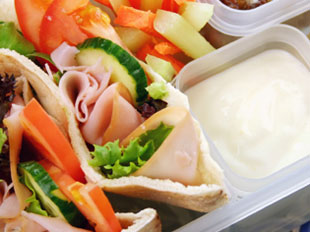Filling Your Plate
 The USDA recently issued new dietary guidelines to help steer consumers onto the right nutrition track. Learn how you can fill the food plate with realistic goals.
The USDA recently issued new dietary guidelines to help steer consumers onto the right nutrition track. Learn how you can fill the food plate with realistic goals.
- Color your plate. Don’t get discouraged counting vegetables and fruit; instead try to draw an imaginary line through the center of your plate and fill half with your produce portion.
- Make it whole. When choosing your daily portions, make sure half of them are whole grains, such as brown rice, oatmeal, whole wheat, and whole rye. Whole grains are important sources of fiber, thiamin, riboflavin, niacin, and folate as well as iron, magnesium, and selenium. They can help reduce the risk of some chronic diseases and aid in weight management.
- Switch to low–fat dairy. Choose low–fat or skim options. Blend a fruit and yogurt smoothie for breakfast. Top casseroles, soups, stews, or vegetables with low–fat cheese. Lactose intolerant? Try canned sardines, salmon with bones, soybeans, kale, or fortified juices, cereals, or breads.
- Minimize meat. For most, meat is the centerpiece of at least 1 meal/day; and that portion probably is more than you need. But you don’t have to ban all meat; just scale back with lower–fat cuts. Choose lean beef, poultry, and fish. Pick a meatless night each week. Substitute plant–based proteins like nuts and beans. View meat as a garnish rather than the main course

